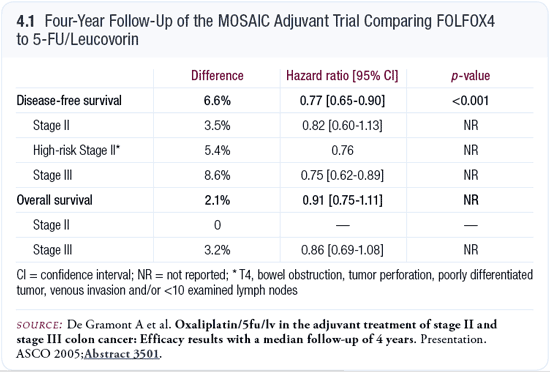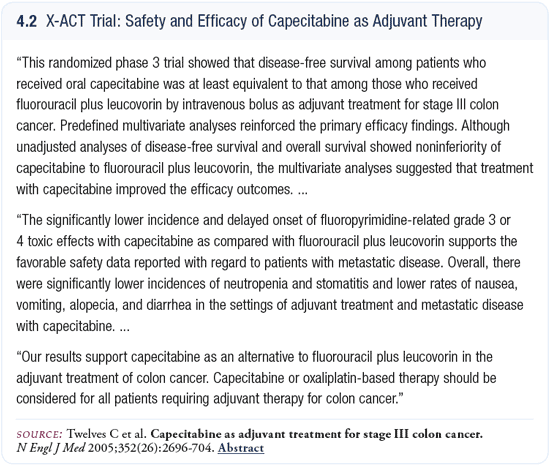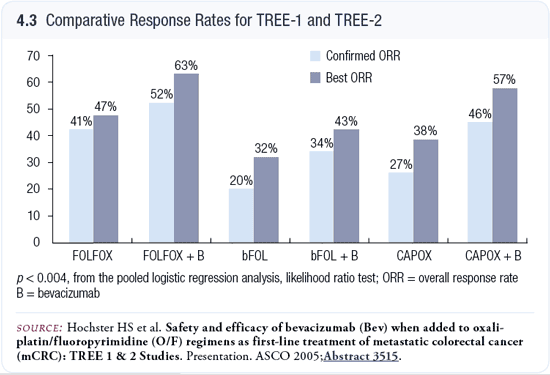You are here: Home: CCU 5 | 2005: Axel Grothey, MD
| Axel Grothey, MD |
EDITED COMMENTS |
 Clinical trials with adjuvant oxaliplatin in patients with colon cancer Clinical trials with adjuvant oxaliplatin in patients with colon cancer
The MOSAIC trial compared FOLFOX4 to infusional 5-FU/leucovorin, and three-year disease-free survival was superior in patients treated with adjuvant FOLFOX with oxaliplatin (Andre 2004). An improvement in disease-free survival is a surrogate marker for overall survival, according to the analysis by Dan Sargent (Sargent 2004). At that point, we had one trial demonstrating that the addition of oxaliplatin to a 5-FU-based regimen could have benefit in the adjuvant therapy of colon cancer.
This year, a trial of a bolus 5-FU regimen with oxaliplatin supported this idea. The results from NSABP-C-07 were more positive than most experts expected. NSABP-C-07 randomly assigned patients with Stage II or III colon cancer to receive the Roswell Park regimen of 5-FU/leucovorin (three cycles of an eightweek regimen) with or without oxaliplatin 85 mg/m2 administered weeks one, three and five (FLOX; [Wolmark 2005]).
FOLFOX versus FLOX
Compared to the FOLFOX4 regimen used in the MOSAIC adjuvant trial, the FLOX regimen in NSABP-C-07 had the same duration of therapy but a lower cumulative dose of oxaliplatin (765 mg/m2 versus 1,020 mg/m2). Although the dose intensity of oxaliplatin was lower and a bolus 5-FU regimen was used as the backbone for the FLOX regimen, they found an increase in the three-year disease-free survival that was almost identical to that in the MOSAIC trial — about a five percent absolute increase (Wolmark 2005).
This suggests that the addition of oxaliplatin to any 5-FU-based regimen is of benefit in the adjuvant setting. Secondly, it shows we probably have two alternatives to choose from — FOLFOX or FLOX. Interestingly, we have the same effect with a lower cumulative dose of oxaliplatin. In the MOSAIC trial, the median dose intensity of oxaliplatin was only 81 percent (Andre 2004). Patients did not receive the six-month cumulative dose of oxaliplatin. The question is, can we use just four months or three months of therapy?
The fact that adjuvant FLOX was at least in the same range of efficacy as adjuvant FOLFOX is surprising because of the data from the TREE-1 and TREE-2 trials just reported at ASCO (Hochster 2005). Those trials compared modified FOLFOX6, CAPOX and bFOL (a bolus 5-FU/leucovorin/ oxaliplatin regimen developed by Howard Hochster at NYU). In these sequential Phase II trials, bFOL was clearly the inferior regimen in terms of response rate. Therefore, it’s interesting that the FLOX regimen of bolus 5-FU/leucovorin/oxaliplatin could be effective in the adjuvant setting.
Overall, FLOX appears to be more toxic than FOLFOX, but the incidence of Grade III neurotoxicity was lower with FLOX in NSABP-C-07 (eight percent; [Wolmark 2005]) than with FOLFOX4 in the MOSAIC trial (12 percent; [Andre 2004]), mainly because the target cumulative dose was lower.
In my practice, I would still use adjuvant FOLFOX as the standard of care in the adjuvant setting because it’s more tolerable, but I would probably stop the oxaliplatin as soon as patients report Grade II neurotoxicity. I would try to reach four months of therapy (eight cycles), which is tolerable for most patients. In former adjuvant settings, we have tried to push to toxicity because we thought we needed duration of therapy and dose intensity for the benefit. NSABP-C-07 might indicate that we don’t have to push beyond a certain cumulative dose of oxaliplatin.
MOSAIC trial update
The recent ASCO update demonstrates that the difference in disease-free survival is maintained over time. After four years of follow-up, the absolute difference in disease-free survival is 8.6 percent in patients with Stage III disease. In patients with Stage II disease, we’re seeing a difference of around three or more percent, which is not yet statistically significant. The survival difference is in the range of two percent (de Gramont 2005; [4.1]).
We will not necessarily see a significant difference in overall survival yet, because as soon as a patient relapses, we have active treatments that keep the patients alive. One interesting tidbit from Dr de Gramont’s presentation was that those patients who did relapse after adjuvant FOLFOX apparently did not respond as well to systemic chemotherapy (de Gramont 2005). This might indicate that those patients who relapse after adjuvant FOLFOX are probably a poor-prognosis group of patients who don’t respond to chemotherapy as well in the palliative setting.
When we consider the actual toxicity differences between 5-FU/leucovorin and FOLFOX4 in the MOSAIC trial, the most critical point is that we don’t see a difference in mortality. We have 0.5 percent of patients dying on therapy in both arms. FOLFOX4 is associated with neutropenia, but patients don’t necessarily experience neutropenia as a clinical symptom unless they have febrile neutropenia, which occurred in only about two percent of the patients.
The key difference is in neurotoxicity. We’ve seen that the vast majority of patients experience reversibility of these neurotoxicity symptoms. A few patients are left with Grade II or Grade III neurotoxicity more than two years after chemotherapy, but it’s a minority (de Gramont 2005).

Adjuvant therapy for patients with Stage II disease
Patients with high-risk Stage II disease should be offered adjuvant FOLFOX. We have reliable and well-validated risk factors to tell us which patients are at higher risk: patients with T4/N0 tumors, an inadequate number of lymph nodes sampled (<10), obstruction or perforation at clinical presentation, angiolymphatic invasion in their tumor specimen or undifferentiated tumors.
These tumor characteristics could lead us to treat those patients with adjuvant FOLFOX. A nonplanned, exploratory subgroup analysis of the MOSAIC adjuvant trial evaluated those patients with high-risk Stage II disease and demonstrated that they have exactly the same benefit as patients with Stage III colon cancer (Hickish 2004). For me, that analysis also says that if you don’t have these risk factors, you probably do not benefit from adjuvant chemotherapy.
Update of the X-ACT adjuvant trial
The trial randomly assigned patients to receive capecitabine or the Mayo Clinic 5-FU regimen, which is probably an inferior regimen. Based on this comparison, in almost 2,000 patients with Stage III disease, capecitabine didn’t appear to be inferior and may be better (Twelves 2005a; [4.2]).
In the recent update of the trial, the curves for disease-free survival and overall survival look better. There was a nonstatistically significant absolute difference in the range of three percent for three-year disease-free survival and overall survival favoring capecitabine (Twelves 2005b). Superiority was never an endpoint of the trial, but we can conclude that capecitabine is a substitute for bolus 5-FU/leucovorin.
The safety analysis in this mainly European patient population showed that 2,500 mg/m2 per day of capecitabine was more tolerable than the Mayo Clinic regimen. About 57 percent of patients required capecitabine dose modifications (Twelves 2005a), which is more or less what we experience in clinical practice. The need for dose reductions is probably higher in the United States. In my personal view, we should start with the established dose but keep a close eye on the patient and reduce the dose until the patient can tolerate the capecitabine.

Neoadjuvant chemotherapy for patients with rectal cancer
The Mayo Clinic is a conservative institution, and we are using continuous- infusion 5-FU in this situation, but I think the data are compelling that capecitabine can be used as a substitute. Outside of clinical trials, we shouldn’t be afraid to use capecitabine. Having said that, this is currently being investigated in NSABP-R-04, which compares radiation therapy with either capecitabine or infusional 5-FU. A second randomization will evaluate the addition of oxaliplatin.
The future involves increasing the efficacy of neoadjuvant chemotherapy because in the end, patients eventually succumb to distant metastases. Adding more effective chemotherapy up front in combination with radiation therapy will allow us to maintain systemically active chemotherapy, which might attack micrometastases as early as possible. I’m sure it will enhance the pathologic complete response rate following chemoradiation therapy, which is a predictor for overall survival. Hence, we’ll have local control improvement, and with the use of combination chemotherapy early on, we might have an impact on distant metastases.
TREE-1 and TREE-2 trials: First-line therapy for metastatic colorectal cancer
TREE-1 and TREE-2 were sequential trials based on different fluoropyrimidines being tested with oxaliplatin — CAPOX versus modified FOLFOX6 versus bFOL. When bevacizumab became available, the study was amended to include all three different combination regimens plus bevacizumab. What we have seen in TREE-1 and TREE-2 combined is that bFOL was inferior in terms of response rate (Hochster 2005; [4.3]).
In TREE-1, the CAPOX regimen used a high dose of capecitabine (1,000 mg/m2 twice a day for 14 days), which was associated with the highest rate of diarrhea and hand-foot syndrome during the first 12 weeks of treatment. For TREE-2, the capecitabine dose was reduced to 850 mg/m2, which led to much better tolerability — lower incidences of diarrhea and hand-foot syndrome — while still maintaining efficacy. In TREE-2, the efficacy of CAPOX plus bevacizumab was comparable to modified FOLFOX6 plus bevacizumab in terms of response rate and definitely better than bFOL plus bevacizumab (Hochster 2005).

Continuation of bevacizumab following disease progression
I personally continue bevacizumab because of the idea that it works on normal, genetically stable cells. My hypothesis is that the resistance we observe with FOLFOX/bevacizumab as first-line therapy is to FOLFOX, not to bevacizumab. Bevacizumab enhances the activity of chemotherapy; in colorectal cancer, it has been shown for 5-FU, irinotecan, cetuximab and oxaliplatin.
As we’re targeting genetically stable endothelial cells that provide neovascularization to the tumor, I think it makes sense to use it this way. The role of bevacizumab following disease progression, however, is unclear. This is the main reason SWOG and NCCTG will be conducting a trial, the Intergroup Bevacizumab Continuation trial, in which patients who have progressed on FOLFOX/bevacizumab or FOLFOX followed by 5-FU/leucovorin/bevacizumab will be randomly assigned to additional therapy with or without bevacizumab.
Select publications
 |
Dr Grothey is a physician at the Mayo Clinic College of Medicine in Rochester, Minnesota. |
|

